The Grey Heron (Ardea cinerea) is a majestic bird commonly found across Europe, Asia, and Africa. Its distinctive grey plumage, long legs, and dagger-like bill make it easily recognizable as it gracefully stalks the shores of rivers, lakes, and wetlands.
Renowned for its patience and stealth, the Grey Heron is a skilled hunter, primarily feeding on fish, amphibians, and small mammals.
It employs a unique hunting technique, standing motionless for extended periods before striking with lightning speed to capture its prey.
Despite habitat loss and human disturbance, the Grey Heron remains adaptable and resilient, maintaining stable populations in various environments.
Its presence enriches ecosystems and serves as a symbol of resilience and adaptability in the face of environmental challenges.
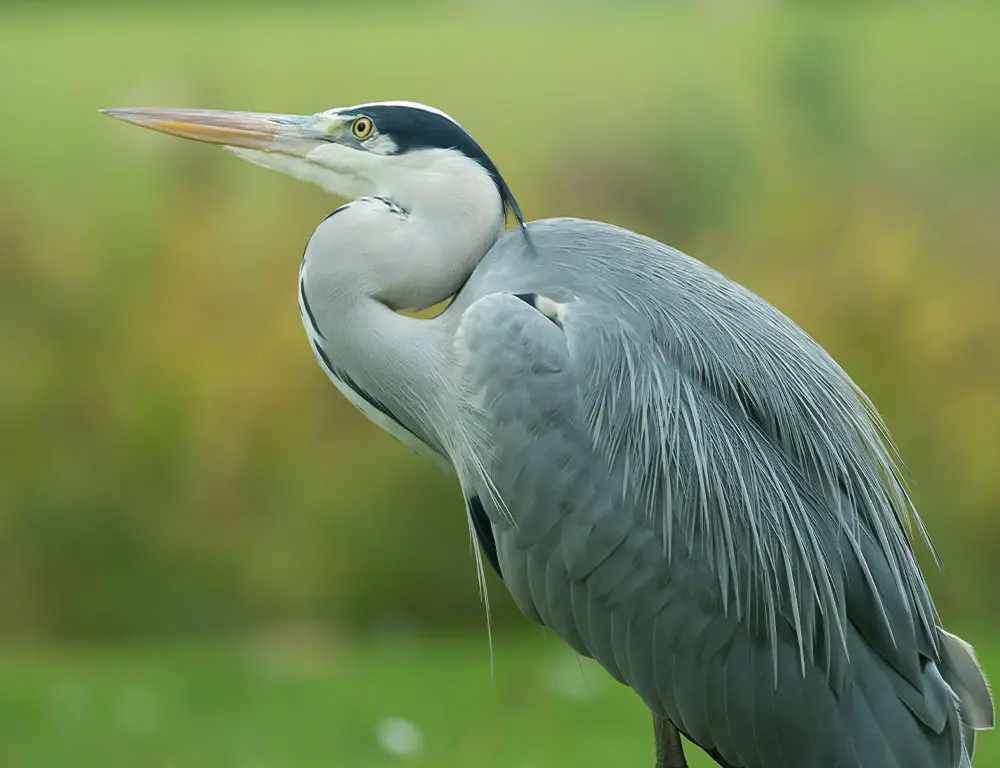
How to Identify Grey Heron?
Identifying the Grey Heron (Ardea cinerea) can be an enriching experience for bird enthusiasts and nature lovers alike. Its distinctive features and behaviors set it apart from other avian species.
Here’s a detailed guide on how to identify this majestic bird:
Size and Shape
The Grey Heron is a tall bird, ranging from 90 to 100 centimeters (35 to 39 inches). Its long, slender neck extends gracefully from its compact body, giving it an elegant appearance.
The wingspan of the Grey Heron can reach up to 175 centimeters (69 inches), providing impressive aerial prowess.
Plumage Coloration
As its name suggests, the Grey Heron’s plumage predominantly consists of shades of grey. Its head, neck, and body are covered in pale grey feathers, while its wings and upper back are darker grey.
During the breeding season, adults develop elongated plumes on their heads and necks, adding a touch of elegance to their appearance.
Bill Structure
One of the most prominent features of the Grey Heron is its long, sharp bill. The bill is yellowish-grey, with a distinctive dagger-like shape ideal for spearing fish, its primary prey.
The bill’s length and slender profile are crucial identifiers when distinguishing the Grey Heron from other species.
Leg Length
Grey Herons possess long, thin legs that are yellowish. These legs are well-adapted for wading through shallow water, enabling the bird to approach its prey stealthily.
Their elongated legs are a key characteristic that aids in their identification, especially when observing them in their natural habitat.
Flight Pattern
When in flight, the Grey Heron exhibits a slow, deliberate wingbeat, with its neck folded back in an S-shaped curve. Its wings are broad and rounded, facilitating effortless gliding through the air.
Observing the Grey Heron’s flight pattern can provide valuable clues for identification, particularly when distinguishing it from similar-looking birds.
Behavioral Traits
The Grey Heron is often observed standing motionless at the water’s edge, patiently waiting for prey to come within striking distance. Its stealthy hunting technique and focused demeanor are distinctive behavioral traits that aid in its identification.
Voice
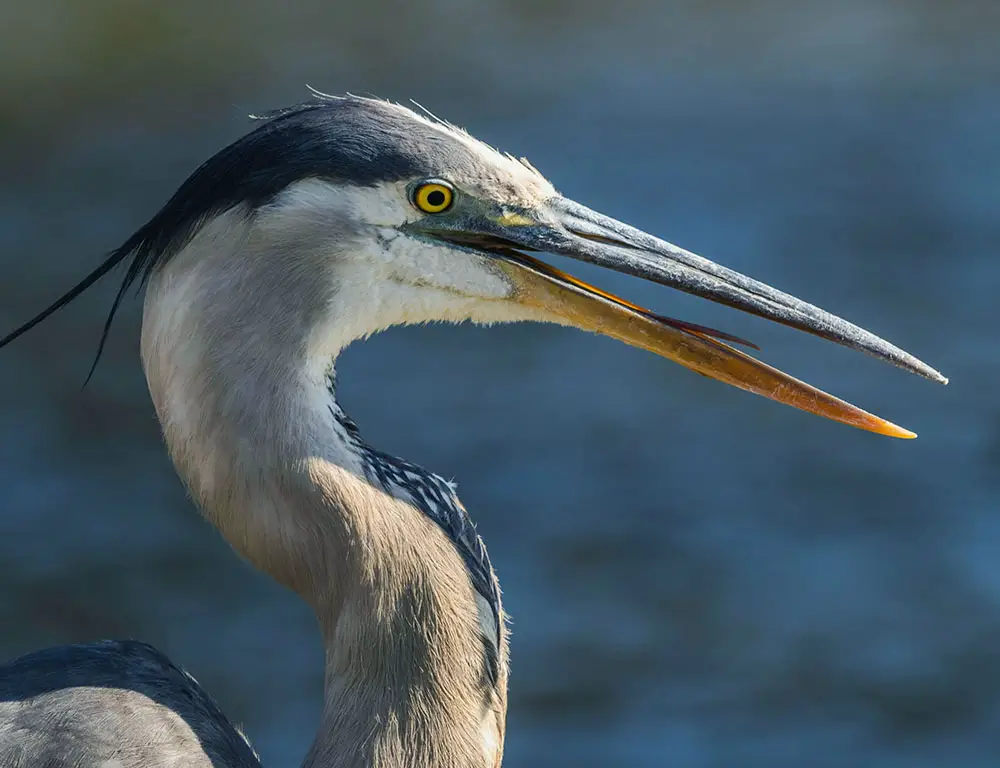
While not as conspicuous as its physical features, the Grey Heron’s vocalizations can also assist in identification. It produces a deep, hoarse croaking sound, often heard during courtship displays or when disturbed.
By paying attention to these distinguishing characteristics, birdwatchers can confidently identify the Grey Heron and appreciate its beauty and ecological significance in natural ecosystems.
Taxonomy of Grey Heron
Here is a table showcasing all the necessary details of the taxonomy of Grey Heron:
| Taxonomic Rank | Classification |
| Domain | Eukaryota |
| Kingdom | Animalia |
| Phylum | Chordata |
| Class | Aves |
| Order | Pelecaniformes |
| Family | Ardeidae |
| Genus | Ardea |
| Species | Ardea cinerea |
The Grey Heron (Ardea cinerea) exhibits remarkable diversity across its range, with four distinct subspecies recognized:
A. c. cinerea (Linnaeus, 1758)
This subspecies, often called the nominate subspecies, is found in Europe, Africa, and western Asia. It is widespread and commonly observed in various freshwater and coastal habitats.
A. c. cinerea typically displays the typical grey plumage characteristic of the species.
A. c. jouyi (Clark, 1907)
The subspecies A. c. jouyi is primarily found in eastern Asia. It inhabits regions such as China, Japan, and Korea, where it can be observed in wetlands, rice paddies, and coastal areas.
While similar in appearance to the nominate subspecies, slight variations may exist in plumage coloration and size.
A. c. firasa (Hartert, 1917)
Restricted to the island of Madagascar, A. c. firasa is a unique subspecies of Grey Heron. It has adapted to the distinct ecosystems found on the island, including coastal mangroves, inland wetlands, and rice fields.
This subspecies may exhibit subtle differences in plumage and behavior compared to its mainland counterparts.
A. c. monicae (Jouanin & Roux, 1963)
Found on islands off Banc d’Arguin, Mauritania, A. c. monicae is a localized subspecies of Grey Heron. Its distribution is limited to specific coastal habitats in the region.
Like other subspecies, A. c. monicae shares the characteristic features of the Grey Heron but may display unique adaptations to its island habitat.
Each Grey Heron subspecies contributes to the species’ overall diversity and ecological significance.
Grey Heron Life History
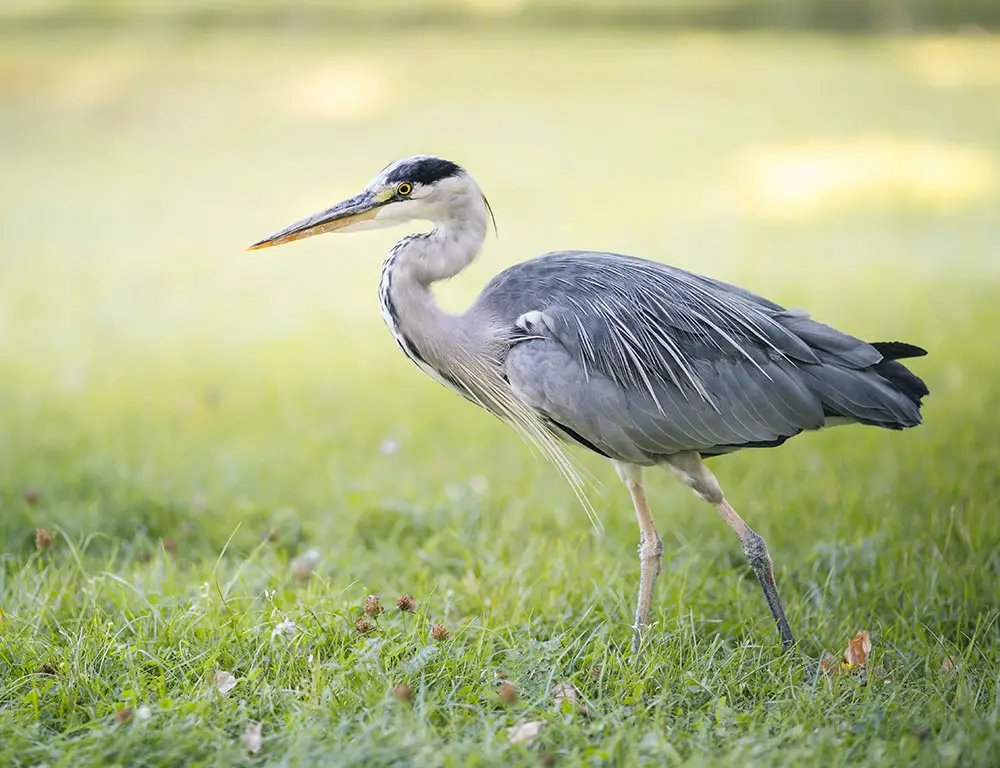
The Grey Heron (Ardea cinerea) is a captivating bird with a rich life history intricately woven into the fabric of wetland ecosystems.
From its diverse diet and adaptable habitats to its breeding behaviors and conservation challenges, the Grey Heron’s life history offers insights into the complexities of avian ecology and conservation.
Food
The Grey Heron is a proficient hunter, primarily feeding on fish, amphibians, small mammals, and occasionally birds.
With its sharp bill and patient demeanor, it stalks shallow waters, employing a sit-and-wait strategy before striking with lightning speed to capture prey.
This dietary versatility enables the Grey Heron to thrive in various aquatic habitats, from rivers and lakes to marshes and coastal estuaries.
Habitat
Grey Herons inhabit many aquatic habitats, including freshwater lakes, rivers, marshes, wetlands, and coastal estuaries.
They are often found in natural and human-altered landscapes, displaying remarkable adaptability to urban environments.
Their presence serves as an indicator of ecosystem health, highlighting the importance of preserving wetland habitats.
Range Map
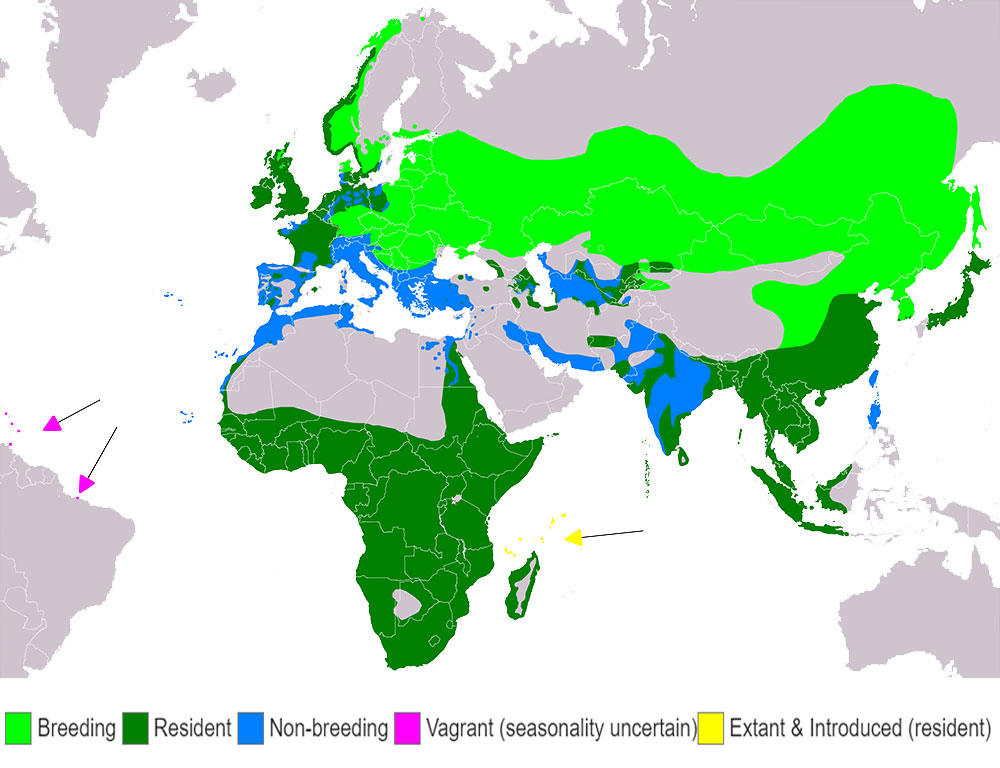
The Grey Heron’s range spans Europe, Asia, and parts of Africa, with distinct subspecies occupying specific regions.
A range map illustrates the distribution of Grey Heron populations, highlighting key breeding and wintering grounds and migration routes crucial for conservation planning and management efforts.
Nesting
During the breeding season, Grey Herons construct large stick nests in trees, reed beds, or on cliffs, often in colonies known as heronries.
These nests provide a haven for raising chicks, protected from predators and inclement weather. Both parents participate in nest building and incubation, demonstrating parental solid care behaviors.
| Nesting Details | Facts |
| Clutch Size | Typically 3 to 5 eggs |
| Number of Broods | Usually 1 brood per season |
| Egg Length | Approximately 60-70 mm |
| Egg Width | Approximately 42-47 mm |
| Incubation Period | Around 25 to 30 days |
| Nestling Period | Approximately 45 to 55 days |
| Egg Description | It is constructed of sticks, twigs, and other plant materials, often in trees, reed beds, or cliffs. |
| Nest Construction | Chicks are altricial, hatching with closed eyes and sparse down feathers. They are cared for by their parents until they become independent. |
| Parental Care | Both parents participate in nest building, incubation, and feeding of chicks. |
| Fledgling Development | Chicks are altricial, hatching with closed eyes and sparse down feathers. They are cared for by parents until they become independent. |
Breeding
Breeding occurs in spring and summer, marked by elaborate courtship displays involving aerial maneuvers, bill-clapping, and mutual preening.
Once paired, Grey Herons engage in cooperative nest building and incubation, with chicks hatching after around 25 to 30 days.
The fledglings are cared for by both parents, learning essential skills such as foraging and predator avoidance before becoming independent.
Diseases and Treatment
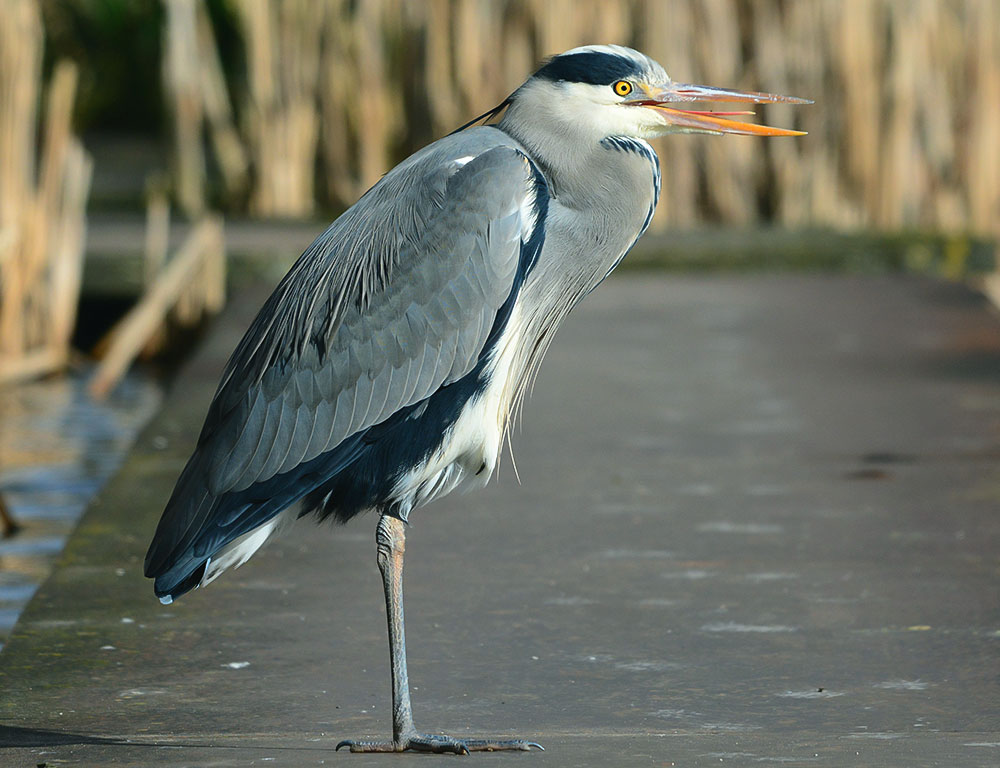
Grey Herons are susceptible to various diseases, including avian botulism, avian influenza, and parasitic infections.
Conservation efforts often involve monitoring and managing disease outbreaks through vaccination programs, habitat restoration, and captive breeding initiatives.
Veterinary care may include treatment for injuries, infections, and nutritional deficiencies, with rehabilitated individuals released back into the wild whenever possible.
Conservation Status
The Grey Heron holds a conservation status of Least Concern according to the International Union for Conservation of Nature.
This classification stems from its sizable population estimated between 790,000 to 3,700,000 individuals and its extensive geographical range, signifying a stable and healthy existence in the wild.
10 Fun Facts About Grey Heron
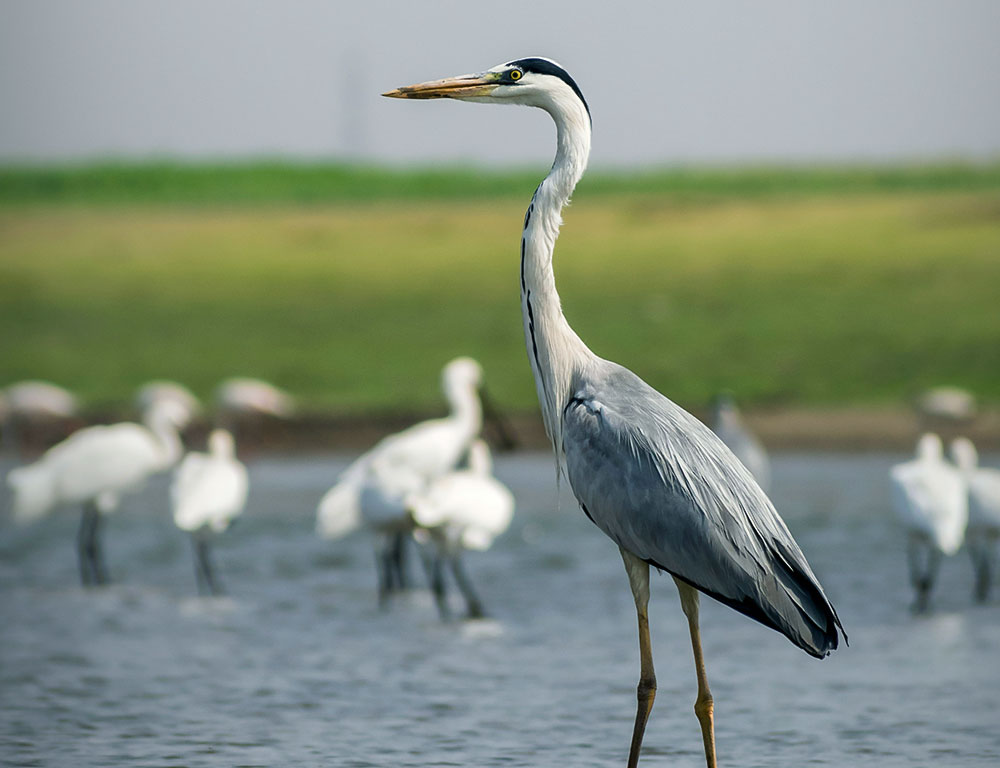
The Grey Heron (Ardea cinerea) is a fascinating bird known for its grace, adaptability, and distinctive hunting techniques.
Here are 10 fun facts about this iconic avian species:
- Majestic Stature: Grey Herons stand tall, with adults reaching heights of up to 100 centimeters (39 inches) and boasting an impressive wingspan of around 175 centimeters (69 inches).
- Patient Predators: These birds are masters of patience, often standing motionless at the water’s edge for extended periods, waiting for the perfect moment to strike at unsuspecting prey.
- Adaptable Diet: While fish make up a significant portion of their diet, Grey Herons are opportunistic feeders, dining on amphibians, small mammals, insects, and even birds.
- Distinctive Plumage: Their plumage is predominantly grey, with pale grey feathers covering the head, neck, and body and darker grey feathers adorning the wings and upper back.
- Elegant Flight: In flight, Grey Herons exhibit slow, deliberate wingbeats, often with their necks folded back in an S-shaped curve, showcasing their aerial grace.
- Nesting Behavior: During the breeding season, Grey Herons construct large stick nests in trees, reed beds, or cliffs, often forming colonies known as heronries.
- Parental Care: Both parents participate in nest building, incubation, and feeding of chicks, demonstrating parental solid care behaviors.
- Distinct Subspecies: Grey Herons exhibit geographic variation, with subspecies found in Europe, Asia, Africa, and Madagascar, each adapted to its specific habitat.
- Longevity: These birds have remarkable lifespans, with individuals known to live for over 25 years in the wild, showcasing their resilience and adaptability.
- Conservation Concerns: Despite their adaptability, Grey Herons face conservation challenges due to habitat loss, pollution, and human disturbance, highlighting the importance of conservation efforts to protect these iconic birds and their wetland habitats.
Wrap Up
The Grey Heron, with its elegant stature and remarkable adaptability, stands as a symbol of resilience and grace in the avian world.
Through its widespread distribution across diverse habitats, from wetlands to urban areas, the heron exemplifies nature’s ability to thrive amidst changing environments.
Its long, slender neck and dagger-like beak aid in efficient hunting, while its patient demeanor embodies a lesson in perseverance.
Beyond its ecological significance, the Grey Heron holds cultural and spiritual importance in many societies, often revered as a symbol of wisdom and tranquility.
The Grey Heron serves as a reminder of the interconnectedness of all living beings and the importance of conserving our natural world for future generations to admire and cherish.